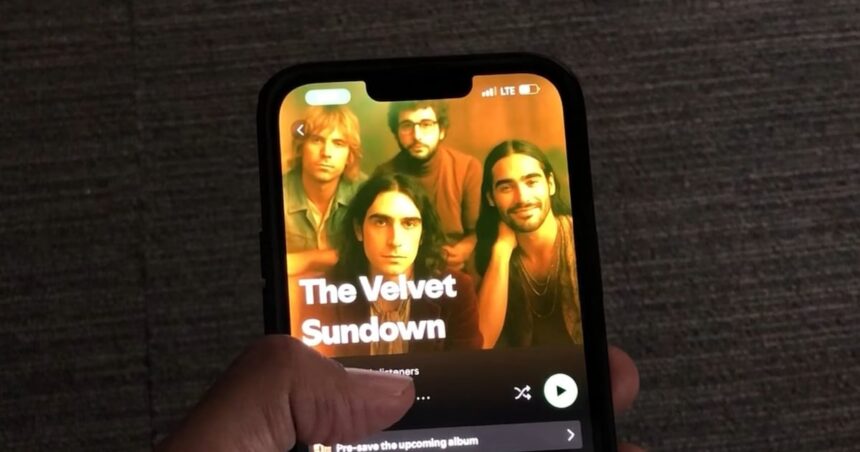Imagine turning on your favorite streaming platform, falling in love with a new band, and then discovering those haunting vocals and perfect guitar riffs weren’t created by humans at all. This scenario isn’t hypothetical anymore. It’s playing out in real-time with the mysterious musical sensation Velvet Sundown, whose meteoric rise has thrust AI-generated music into an uncomfortable spotlight.
The band appeared seemingly out of nowhere last month with their debut single “Midnight Machines,” which has amassed over 12 million streams across platforms. Their dreamy, nostalgic sound evokes comparisons to Mazzy Star and early Beach House—yet unlike those acts, no interviews exist, no tour dates are announced, and industry insiders increasingly suspect the entire project is AI-generated.
“What we’re witnessing is likely the first truly successful AI music project to break into the mainstream without announcing itself as such,” says Priya Sharma, music technology researcher at York University. “The technical markers are there if you know what to look for—certain repetition patterns in the vocal melodies and too-perfect instrumental synchronization.”
The band’s label, Horizon Collective, has remained conspicuously silent about the artists behind the project, fueling speculation. Their press releases describe Velvet Sundown as “boundary-pushing” and “innovative” without providing basic information like band members’ names or backgrounds.
Music industry professionals are divided. Some see AI music as an existential threat, while others view it as simply another production tool. Maria Gonzalez, CEO of the Canadian Musicians Association, expressed concern: “If this is indeed AI-generated content masquerading as human artistry, it raises serious questions about transparency and authenticity in the streaming ecosystem.”
Those concerns extend beyond artistic integrity to economics. Streaming platforms pay royalties into a shared pool that’s distributed based on play counts. Every dollar that goes to an AI project potentially comes at the expense of human musicians already struggling in the digital economy.
The legal landscape remains murky. Current copyright laws weren’t designed with AI-generated art in mind. The U.S. Copyright Office has maintained that works must be human-created to receive protection, but enforcing this standard proves difficult when AI outputs increasingly mimic human creativity.
“The real issue isn’t whether AI can make music—it’s whether audiences deserve to know what they’re listening to,” argues entertainment lawyer Daniel Chen. “Transparent labeling would allow consumers to make informed choices about supporting human or AI-created content.”
For independent artists like Toronto-based singer-songwriter Maya Williams, the situation feels particularly threatening. “I spend years developing my craft, pouring my lived experiences into lyrics, and struggling to get noticed. Then an algorithm can simulate that overnight and potentially take my streaming revenue? It’s demoralizing.”
Not everyone sees disaster on the horizon. Music producer Alex Thompson believes AI will ultimately serve as a collaborator rather than a replacement. “Throughout history, new technologies from synthesizers to Auto-Tune faced resistance before becoming accepted tools. The artists who embrace AI as a creative partner rather than fearing it will likely define the next era of music.”
The streaming platforms themselves have remained largely silent on the matter. Neither Spotify nor Apple Music has implemented any labeling system to distinguish AI-generated content from human-created works. Internal sources at one major platform, speaking on condition of anonymity, revealed that discussions about such policies are ongoing but complicated by technical challenges in reliably detecting AI music.
The debate extends beyond the music industry. Similar conversations are happening in visual art, literature, and film as generative AI increasingly blurs the line between human and machine creativity. Each field grapples with questions of authorship, authenticity, and economic impacts as algorithms become increasingly capable of mimicking human expression.
What makes Velvet Sundown particularly notable is their commercial success despite—or perhaps because of—their mysterious nature. Their second single “Analog Dreams” debuted on several influential playlists last week, suggesting that whatever debate rages behind the scenes, listeners are connecting with the music regardless of its origin.
Cultural critic James Kim suggests this points to a deeper truth: “Perhaps what matters isn’t whether algorithms or humans created the art, but whether it resonates emotionally with audiences. The history of art is filled with technological innovations that initially sparked resistance but eventually expanded our understanding of creativity.”
As Velvet Sundown continues to gain traction, the music industry finds itself at a crossroads. Will transparency become mandatory? Will new economic models emerge to protect human artists? Or will AI-generated content simply become another accepted part of our cultural landscape?
Whatever the outcome, one thing remains clear: the line between human and machine creativity has never been blurrier, and how we navigate this territory will fundamentally reshape our relationship with art in the digital age.






